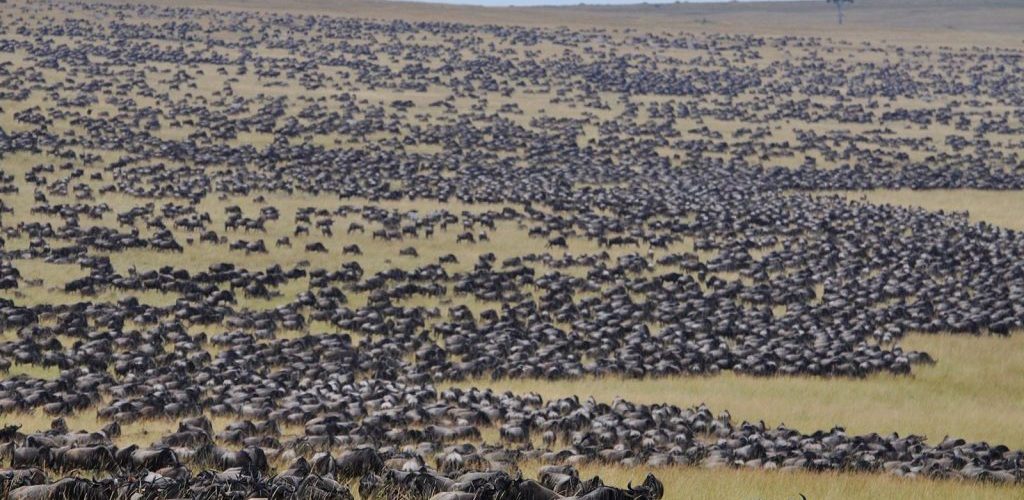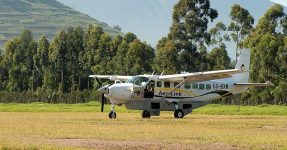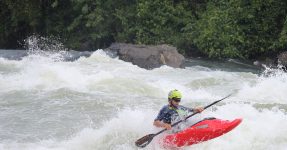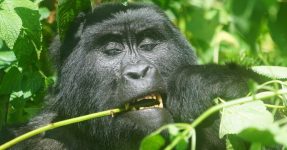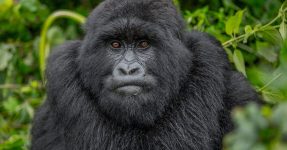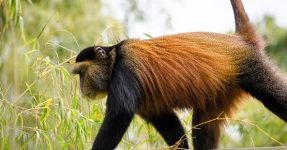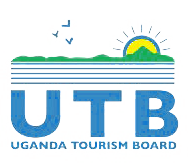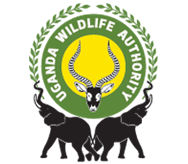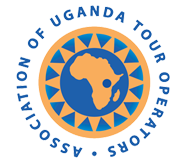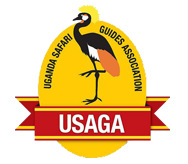The great wildebeest migration and gorilla trekking in Africa: Did you know you can combine the great wildebeest migration and gorilla trekking in Africa in a single trip? Native Africa Tours stands out as one of the best tour companies in Africa that organizes combined gorilla and wildlife safaris. Whether it is a short wildebeest and gorilla trekking safari or a long combined gorilla and wildebeest tour, we are ready to take you there. Wildebeest migration tours in Africa are done in Kenya and Tanzania.
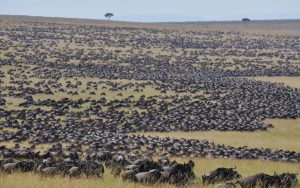
In Kenya, wildebeest migration safaris are done in the vast plains of Masai Mara National Reserve. On the other hand, in Tanzania, one can visit the mighty Serengeti National Park and enjoy this extraordinary adventure (wildebeest migration). In this article, we answer all the frequently asked questions (FAQs) about the great wildebeest migration and gorilla trekking in Africa. If you have been thinking about doing two amazing safari activities in one trip, this article is yours to read.
What is the great wildebeest migration experience?
You must have heard about the term “the great wildebeest migration” or if it is your first time to come across it, do not fret. The great wildebeest migration simply refers to the mass movement of wildebeests, zebras, and many other herbivores in search of greener pastures and water. This movement takes place in Kenya’s Masai Mara National Reserve and Tanzania’s Serengeti National Park. Scientists have not concluded what guides the movement but major theories believe that these animals just follow their instincts. The great wildebeest migration is not just a movement of herbivores. This is what happens.
When the herbivores walk through the savannah plains of Africa, they are followed by carnivores (hunters). This is one of the reasons why you should take on a combined great wildebeest migration and gorilla trekking safari in Africa. Imagine setting your eyes on a pride of lions in Masai Mara hunting down a wildebeest or buffalo. Such scenes are rare and can only be found in Africa.
What is gorilla trekking?
Gorilla trekking or mountain gorilla tracking is one of the popular safari activities done in Africa. The activity can only be done in 3 African countries namely; Uganda, Rwanda, and the Democratic Republic of Congo. It is only in these countries that the critically endangered mountain gorillas are found.
Gorilla trekking simply refers to the process of following mountain gorillas for hours and monitoring their behaviors. Gorilla trekking has strict rules and regulations. For example, only 8 people are allowed to participate in trekking or tracking one mountain gorilla family per day. During a gorilla trekking trip, tourists are briefed about the dos and don’ts of the activities. All these rules and regulations are meant to benefit both wildlife and tourists.
How is the wildebeest migration and gorilla trekking in Africa done?
To begin with, you must note that wildebeest migration tours and gorilla trekking are done in two separate countries. Do not get me wrong, I am not saying that the two activities cannot be done on one trip. All I am saying is that you will have to start with visiting Uganda, Rwanda, and Congo or Tanzania and Kenya. Order does not matter; it all depends on your choices.
How wildebeest migration experience tour is done (Kenya and Tanzania)
A typical wildebeest migration experience day on your Africa safari starts like any other safari day. Should we say with a delicious breakfast or African coffee at your lodge? Yes. Once breakfast, our experienced driver guide will have already come. You enter our 4×4 safari vehicle with a pop-up roof. He or she will drive you to the park headquarters or one of the gates in Masai Mara Reserve (Kenya) or Serengeti National Park in Tanzania. You will pay entry fees and get verified by the park authorities. The real adventure begins here.
You will witness many wildlife species roaming the vast plains of either Masai Mara National Reserve or Serengeti National Park. This is where you prove the expertise and experience of our safari guides. They will explain every detail that they must and answer all your questions. It will not take long before you land on unique animals like cheetahs, leopards, lions, elephants, and zebras, to mention but a few. Additionally, you will see many bird and tree species. The deeper you drive into the park, the sweeter it becomes.
In no time, you will witness millions of wildebeests roaming the endless savannah plains of Tanzania and Kenya. Your driver guide will take you near a water source. For Masai Mara, it is usually the Mara River. For Serengeti National Park, it is usually the Grumeti River. It is on such points that you will witness wildebeests and zebras crossing the rivers.
The Mara River is Africa’s deadliest river since it hosts thousands of crocodiles. The Mara River crossing is a true testament to patience, resilience, and a game of blood. Here, only the strong ones survive and the unlucky become victims of the situation. Lunch is always under a tree in the middle of nowhere. Such moments make a wildebeest migration safari an exceptional adventure.
How is gorilla trekking in Africa done?
Gorilla trekking in Africa is done in Uganda, Rwanda, and the Democratic Republic of Congo. The activity is done in the Virunga Conservation Region. This region covers several national parks in the three countries. In Uganda, gorilla trekking is done in Bwindi Impenetrable National Park and Mgahinga Gorilla National Park.
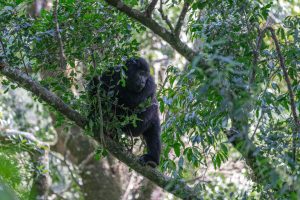
In Rwanda, gorilla trekking is done in Volcanoes National Park. Lastly, in the Democratic Republic of the Congo, gorilla trekking is done in Virunga National Park and Kahuzi Biega National Park. In Kahuzi Biega National Park, tourists take part in lowland gorilla trekking tours. Unlike the rest of the parks, Kahuzi Biega National Park hosts a unique subspecies of gorillas. You can do a combined wildebeest migration and lowland gorilla trekking safari with us. Send your inquiry now for a detailed itinerary.
A typical gorilla trekking day in Africa starts with a delicious breakfast at your lodge. Our driver-guide take you to the park headquarters for a briefing. During the briefing, you will learn about the dos and don’ts of gorilla trekking. One gorilla family is restricted to 8 people per day.
Later on, you will be assigned an armed ranger and a real adventure. You will be guided by signs like dung and leftovers to track the gorillas. Upon meeting the gorilla family, tourists are allowed to spend at least one hour in their presence. Bwindi National Park is home to almost half of the world’s mountain gorilla population. This makes it the best spot for the wildebeest migration and gorilla trekking in Africa tours. The park is divided into four sectors. The overall number of gorilla families in this park is 26.
After trekking mountain gorillas, tourists usually visit the neighboring Batwa villages. Here, tourists participate in the day-to-day lives of the locals. These community tours support locals and are one way of supporting sustainable tourism development goals. Tourists take part in activities like brewing local beer, harvesting crops, traditional dances, and storytelling.
How much is the great wildebeest migration and gorilla trekking safari in Africa?
There is no fixed price for a gorilla trekking and wildebeest migration safari in Africa. Prices vary from one trip to another. It all depends on the number of days and the type of safari. Our tour consultants are always ready to offer you a price that fits your budget. There is always room for negotiations. Talk to our team now.
A gorilla trekking permit in Uganda costs USD 800 per person per trek for foreign non-residents. Foreign residents buy permits at USD 700 per person. In Rwanda, gorilla permits cost USD 1,500 Per person. On the other hand, a typical game drive to see wildebeests in Masai Mara Reserve costs USD 200 per person. Please note that the above-mentioned prices do not include other safari expenses like transport and accommodation.
Flying from Bwindi Impenetrable National Park to Masai Mara National Reserve
Combining gorilla trekking in Uganda and wildebeest migration safaris in Kenya has been made easier. If you track mountain gorillas in either Bwindi Impenetrable National or Mgahinga Gorilla National Park, you need not spend much time on the road to Kenya. We organize chartered flights from Bwindi National Park to Masai Mara via Entebbe International Airport. Please note that this flight does not take you to Nairobi. It rather takes you straight from Uganda to Masai Mara National Reserve. Imagine seeing gorillas today and wildebeests the following day! Airport transfers are always included in these transfers.
Where to stay for a combined wildebeest migration and gorilla trekking safari
Are you planning a combined wildebeest migration and gorilla trekking tour and worried about the best places to spend a night? Do not fret, Uganda, Rwanda, Kenya, and Tanzania have some of the best safari lodges and tented camps for tourists. These accommodation facilities range from budget to mid-range to luxury. Some of the lodges to stay at during such safaris include; Ride 4 a Woman Guest House, Gorilla Leisure Lodge, Four Gorillas Lodge, Ol Moran Tented Safari Camp, Zebra Plains Mara Camp, Serengeti Serena Lodge, and many more.
What is the best time to do a combined wildebeest migration and gorilla trekking safari in Africa?
East Africa is a tropical region crossed by the equator. This implies that the region receives two dry and wet seasons annually. All the parks are open for tourism including on weekends and public holidays. However, the dry seasons (June to September and December to February) are usually deemed the best time for safaris in Africa. This is because roads are easily navigable, and walking through forests on gorilla trekking is easier. Additionally, there is less or no chance of rain during such seasons.
On the other hand, gorilla trekking and wildebeest migration tours can be best done in wet seasons. During such seasons, accommodation prices are usually low. More so, parks receive fewer guests hence a more personalized experience. All in all, the best time for a combined wildebeest migration and gorilla trekking safari in Africa entirely depends on your budget and other safari needs.
Conclusively, booking a combined wildebeest migration and gorilla trekking trip to Africa can be one of the best decisions you can make. With the help of our safari experts, your trip or safari will make your dreams come true. Witness the majestic giants (gorillas) as well as the world’s greatest animal movement (wildebeest migration) and create everlasting memories.



